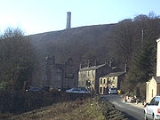
Peel Monument
Encyclopedia



Robert Peel
Sir Robert Peel, 2nd Baronet was a British Conservative statesman who served as Prime Minister of the United Kingdom from 10 December 1834 to 8 April 1835, and again from 30 August 1841 to 29 June 1846...
high above Ramsbottom
Ramsbottom
Ramsbottom is a town in the Metropolitan Borough of Bury, Greater Manchester, England. It is situated on the course of the River Irwell, in the West Pennine Moors. Historically within Lancashire, it is located north-northwest of Bury, and north-northwest of Manchester...
was planned and erected at the same time as Bury
Bury
Bury is a town in Greater Manchester, England. It lies on the River Irwell, east of Bolton, west-southwest of Rochdale, and north-northwest of the city of Manchester...
was preparing its statue to the then recently deceased statesman who was born in Bury.
The tower occupies a prominent position on Harcles Hill (known locally as "Holcombe Hill" due to its location next to Holcombe village) 1100 feet (335 m) above sea level. The monument is believed to have been designed by members of the memorial committee who included the local textile entrepreneur and philanthropist, William Grant. Grant was said to have been responsible for the site which was in a direct line from his own house, Nuttall Hall, and St Andrew's church.
A public subscription provided the £1,000 needed to build the tower. The stone for the tower was obtained from the hillside. The Peel Tower was opened in September 1852, the day after the inauguration of the Baily's statue in Bury
Bury
Bury is a town in Greater Manchester, England. It lies on the River Irwell, east of Bolton, west-southwest of Rochdale, and north-northwest of the city of Manchester...
.
As at the earlier ceremony Frederick Peel was the principal guest of honour, and he declared the monument to be a splendid memorial to his father and to the principles of free trade. Local speakers included Joshua Knowles and John Robinson Kay. Unfortunately, large numbers who had traveled by excursion train from Salford arrived too late to witness the ceremony.
Inside the entrance to the tower is an extract from Peel's speech to the House of Commons in 1846. It emerged later that the tower had been planned and built in such haste that the necessary permission had not been obtained from the owner of the land, the Duke of Buccleuch
Duke of Buccleuch
The title Duke of Buccleuch , formerly also spelt Duke of Buccleugh, was created in the Peerage of Scotland on 20 April 1663 for the Duke of Monmouth, who was the eldest illegitimate son of Charles II of Scotland, England, and Ireland and who had married Anne Scott, 4th Countess of Buccleuch.Anne...
. This matter was eventually rectified in 1868 when the land was transferred into the keeping of six trustees, on the condition that it would not be used for contentious public meetings.
If the tower, in the words of the Manchester Guardian, is not 'a specimen of architectural beauty', it does provide a conspicuous landmark, and it also has a viewing platform from which to look across the surrounding countryside. The original internal staircase eventually became unsafe and was bricked up; later, the tower was reconditioned and a new staircase provided. The tower is 128 feet (39 m) high.
The tower was renovated in 1929 and at various other times. The tower closed after World War Two
World War II
World War II, or the Second World War , was a global conflict lasting from 1939 to 1945, involving most of the world's nations—including all of the great powers—eventually forming two opposing military alliances: the Allies and the Axis...
in 1947 and was reopened and rededicated in November 1985 by Conservative Councillor Alice Maders.

